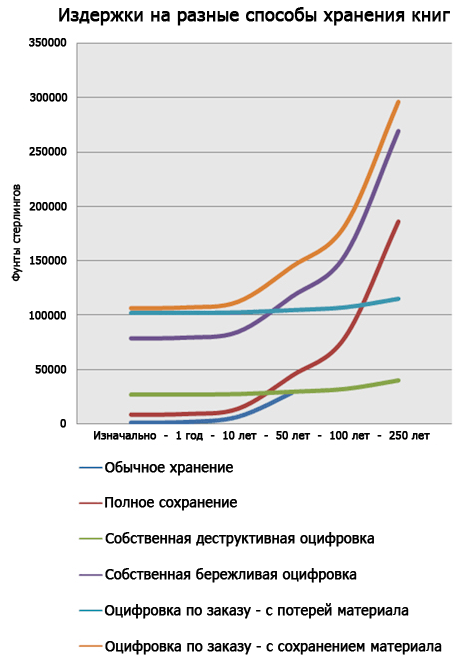Digitization of library funds pays off in 50 years
The British universities of Leeds, Sheffield and York have joined forces for a large-scale LIFE-SHARE project to explore various options for long-term document retention. Obviously, the most profitable is to scan books and store them in digital form. But it is important to have numbers to prove this assumption.
The study showed that the cost of digitization is high, but these costs pay off relatively quickly: after 50 years. In this case, the most profitable option is a destructive scanning of books on their own. At 250 years of age, destructive scanning is about 4.5 times more profitable than storing paper originals.
Here is a list of initial costs, depending on the chosen strategy, taking into account the costs of staff costs.
At the first stage, it would seem that the most budgetary option would be to leave everything as it is - not to touch the books on the shelves (normal storage). But in this case, after 50 years, the cost of storage and the salary of service personnel will exceed the cost of scanning, and indeed, with normal storage, books will not live long.
')
If we compare the cost of each option of storing books for decades ahead, then scanning seems to be the most acceptable option.

The study showed that the cost of digitization is high, but these costs pay off relatively quickly: after 50 years. In this case, the most profitable option is a destructive scanning of books on their own. At 250 years of age, destructive scanning is about 4.5 times more profitable than storing paper originals.
Here is a list of initial costs, depending on the chosen strategy, taking into account the costs of staff costs.
| Strategy | Expenses |
| Normal storage | £ 748 |
| Full save | £ 8372 |
| Own destructive digitization | £ 26,972 |
| Proper lean digitization | £ 78,656 |
| Digitization by request | £ 101,673 (cheapest offer) |
| (with preservation of material) | £ 347,040 (most expensive offer) |
| Digitization by request | £ 106,111 (cheapest offer) |
| (with loss of material) | £ 351,478 (most expensive offer) |
At the first stage, it would seem that the most budgetary option would be to leave everything as it is - not to touch the books on the shelves (normal storage). But in this case, after 50 years, the cost of storage and the salary of service personnel will exceed the cost of scanning, and indeed, with normal storage, books will not live long.
')
If we compare the cost of each option of storing books for decades ahead, then scanning seems to be the most acceptable option.

Source: https://habr.com/ru/post/133675/
All Articles